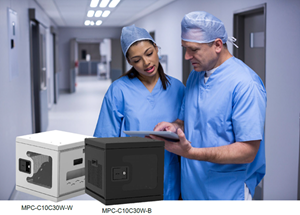 |
 |
 |
|
 |
 |
 |
 |
 |
 |
 |
 |
 |
 |
|
 |
A charging cabinet is suitable for charging 10 to 20 tablets or laptops. The currently popular interfaces are USB-A and USB-C. High-power USB-C charging cabinets can reach up to 65W, and their charging speed and applications vary depending on the choice.
1. USB-A: USB-A (e.g., MPC-C12GA) is one of the most common USB interfaces at present. It is usually used to connect and charge various devices, such as mobile phones, tablets, keyboards, mice, etc. The output power supported by the USB-A charging cabinet is usually 10W, which means that the charging speed it provides is relatively slow. For devices that need fast charging, it may take longer to fully charge. However, the advantage of the USB-A charging cabinet is that it is relatively cheap and widely compatible, and can be used with most USB devices.
2. USB-C: USB-C (e.g., MPC-C10C, MPC-C20C) is a new type of USB interface that can provide higher charging power. The output power supported by the USB-C charging cabinet usually starts at 18W, which means it can provide fast charging for various devices, including mobile phones and tablets. USB-C also supports the fast charging protocol USB Power Delivery (USB-PD) to achieve fast charging and save user time.
The high-power USB-C model (e.g., MPC-C10C-30W, MPC-C10C-45W, MPC-C10C-65W) is a USB-C charging cabinet that supports higher power and charging protocols. It supports mobile phones, tablets, and USB-C charging laptops. Its output charging power can be as high as 65W depending on the model, and it also supports the PPS (Programmable Power Supply) charging protocol, which supports both USB Power Delivery (USB-PD) and Quick Charge (QC) mainstream protocols to cater to different systems. This allows the output voltage to have a wider adjustment range and adjust the output voltage and current according to the status of the charging device. This technology can also reduce conversion losses during charging and improve charging efficiency. In addition, PPS charging can also control the charging temperature, reduce the heating degree of the charging device during charging, and extend the battery life.
In summary, charging cabinets have USB-A, USB-C, and high-power USB-C models, and they differ in USB charging interfaces, speed, and applications. The USB-A charging cabinet is relatively cheap, but the charging speed is slower; the USB-C charging cabinet supports higher power output, provides faster charging speed and will automatically adjust, providing fast charging for various high-power devices. When choosing a charging cabinet, you can choose the most suitable type based on your needs and budget. |
 |
|
|
 |
 |
 |
 |
 |
 |
 |
|
 |
 |
 |
 |
 |
 |
 |
|
 |
|

